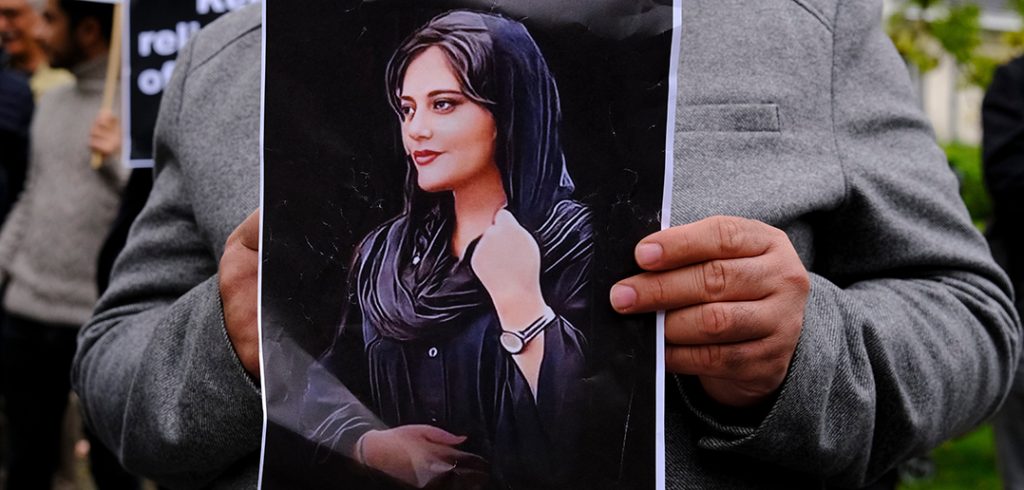That all changed when 22-year-old Mahsa Amini died in police custody on Sept. 16 after she was arrested for wearing her headscarf—or hijab—improperly. The nation’s youth responded with peaceful demonstrations that were met with tear gas and bullets. At least 233 have been killed to date, according to the U.S.-based rights monitor HRANA.
“It’s terrifying. This regime is killing children, women, and men just because they’re protesting,” said Ali, whose last name is being withheld to provide anonymity. “You know, when they kill a 16-year-old girl, when they kill a 22-year-old woman, when they kidnap girls and then give their corpses to their families after 10 days—you can imagine how hard it is.”
Islamic tradition dictates that bodies be buried quickly after death, usually within 24 hours.
The tragic irony of returning the deceased to loved ones 10 days later in the name of morality is just one example of how these violent repercussions have nothing to do with religion, despite the claims of those in power, said Ali.
“This is not Islam. This is not any religion. This is nothing. This is just about power. They’re abusing a word–Islam. They’re abusing this word in order to exploit people. And they have done that for 43 years.”
The Concept of ‘State’ in the Muslim World
Ali’s passionate stance, that the government of the Islamic Republic of Iran is anything but religious, is a complex subject to unravel, said Sarah Eltantawi, Ph.D., an associate professor of theology who specializes in politics and Islam in the contemporary world.
“The whole concept of a state is a modern, western invention,” she said. “Many modern states have been essentially imposed by colonialism on the Muslim majority world.”
She noted that the modern state is not an institution that had been envisioned by the early scholars of Islam, though they did talk about the necessity of political authority being rooted in Islamic legitimacy.
“In my personal opinion, trying to meld ideas of Islamic political rules with the modern state is a combination that is inherently a Frankenstein,” she said.
She added that the current protests cannot simply be framed as the result of zealous religious regulations. American sanctions have also played a role by damaging the Iranian economy and undermining the government’s ability to manage its economy. A strong economy makes strict laws a bit more palatable, she said.
“Everyone will say, ‘Saudi Arabia is only standing because it’s such an authoritarian kingdom.’ No, it’s because people are pretty rich.”
A Sophisticated Public Unaligned With its Government
She said Iran’s situation became combustible after the hardline government of President Ebrahim Raisi was elected in 2021 and tried to impose rules that the general public objected to, such as not showing a strand of hair from under their headscarves.
“Iranian women are very famous for barely even wearing the hijab in the first place,” she said.
Indeed, to compare Iran to places where rules like these are accepted, such as Yemen or Somalia, would be shortsighted, said John Entelis, Ph.D., professor of political science.
“Anyone who knows Iran has always understood its sophisticated nature,” said Entelis. “This is a very advanced society—always has been—that happens to be under the control of a theocracy.”
Indeed, Entelis noted that since the 1979 revolution, elected governments have come and gone without incident, though there always remained an “enormous” gap between the society and its government.
“What’s new is the degree to which society has been willing to respond and to protest the conditions under which they’ve had to exist for all these years,” said Entelis.
He noted that in today’s Iran, religion is often only understood in the context of politics.
“Politics dictates the religious idiom that is used to rationalize and legitimize the actions of those in power,” he said.
Throughout Iran women have been burning their headscarves to protest the government’s co-opting the headscarf as a way to control them. The women, however, do remain faithful to Islam. Their willingness to throw away the scarves should not be seen as an anti-religious act, it should be understood as a political act, he said.
“The women, to me, are an important agent of political change, especially young women,” he said.
Whether their efforts are enough to translate into a revolution is an ongoing question, he said. He noted that while many women in the Middle East region do not have the right to vote, Iranian women not only vote but they can also get elected to the Iranian Parliament. As such, they remain a significant power base. Nevertheless, Entelis said he’s skeptical of the ability of the women and their allies to be agents of change.
Elusive Change
“At the end of the day, the state’s ability and willingness to kill whoever it has to kill to stay in power makes me very pessimistic,” he said.
“And the longer the protests continue without some kind of resolution in their favor, the more difficult it will be for a transformation to take place of any kind.”
For his part, Ali remains hopeful, though he acknowledged the many hurdles. He said he’s seen many protests in his life, but he’s rarely seen them as regularly as he has over the past few weeks. Several protests have been held in New York City as well, with some Fordham students lending their voice to the cause.
And while Ali concurred with Entelis that political change may be very difficult to come by, he expressed optimism that a generational change is underway. Indeed, about half of Iran’s population is under the age of 30.
“When you look at the protests, then you see students who are the next generation of the country; they’re going to build this country again,” said Ali, who plans to return to Iran after finishing his degree. “Even if the revolution doesn’t happen now, it will happen in near future, because they will all remember this.”


